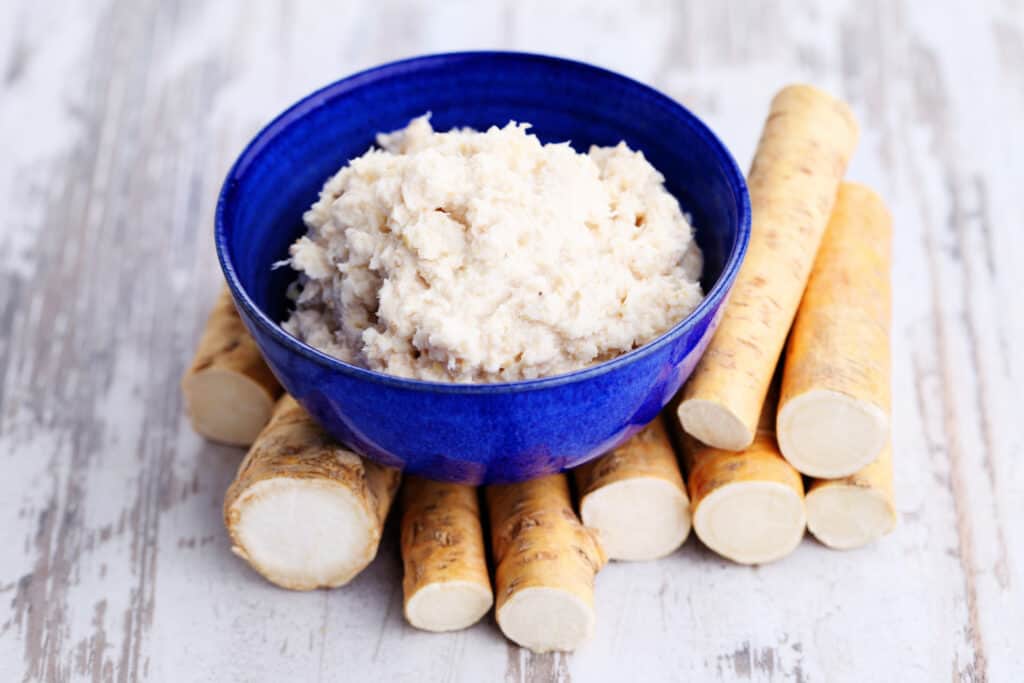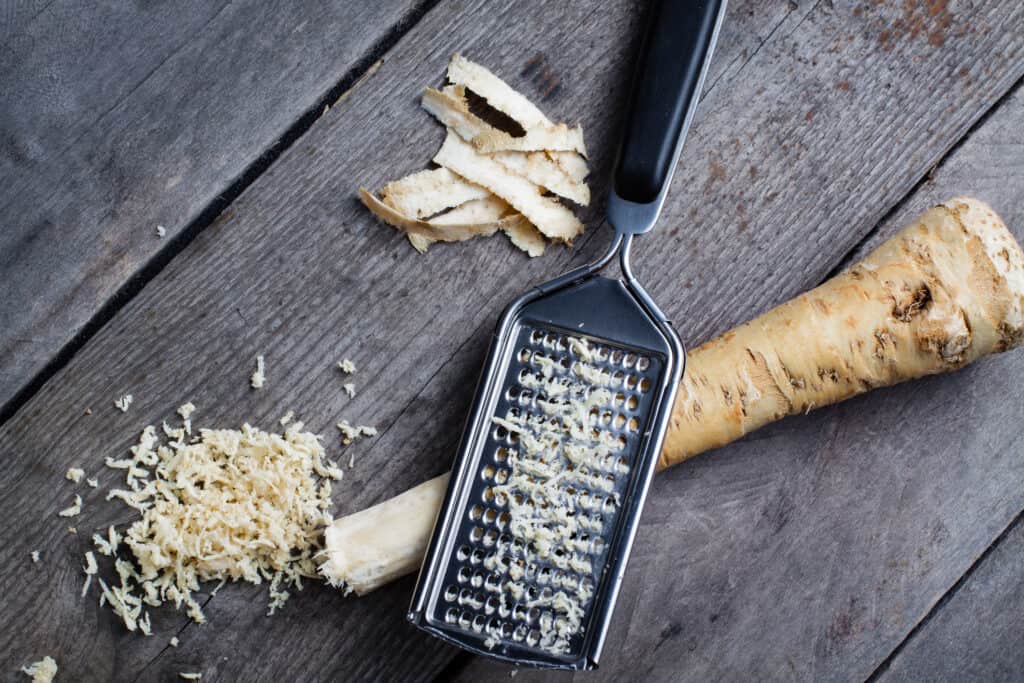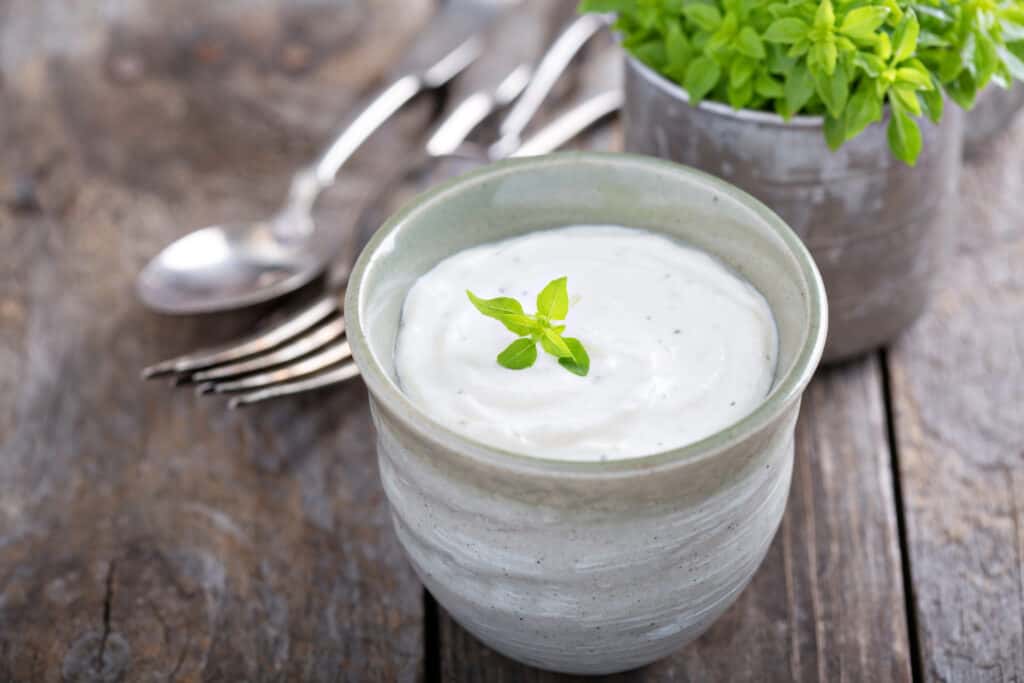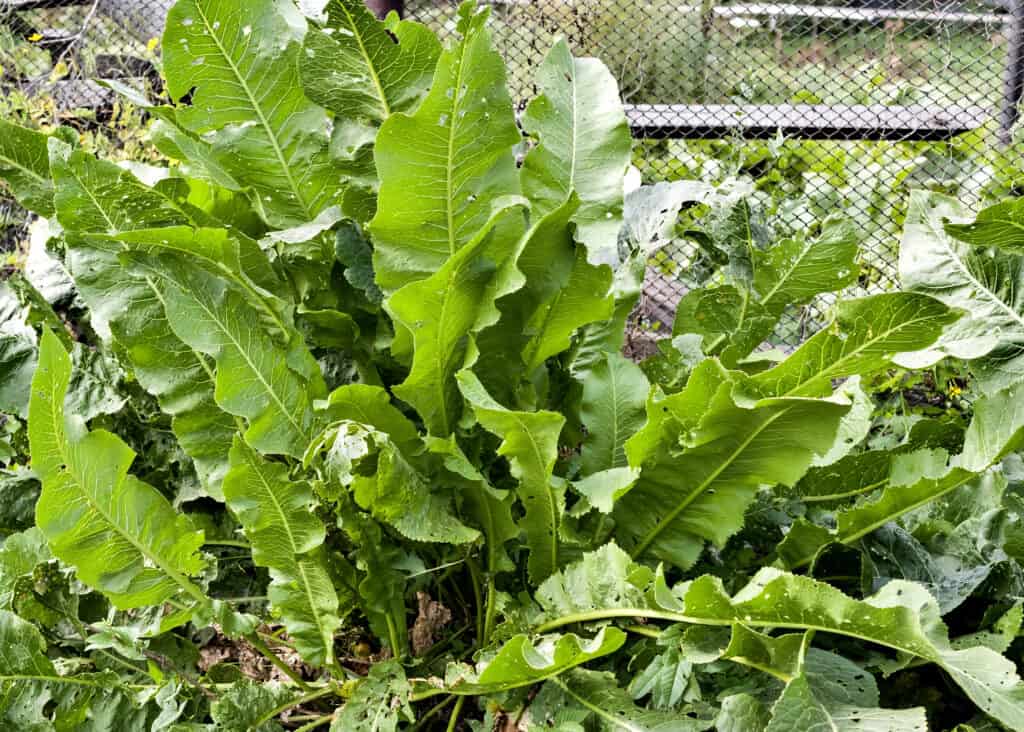The peak season for freshly harvested horseradish is early spring and late fall.
Horseradish is a long, knobby root—it’s an herb, not a vegetable–that has no aroma until you scratch, cut, or grate it.
The pungent odor and the hot taste of horseradish are due to a volatile oil—similar to mustard oil—that is released when the cells of the horseradish root are bruised or broken. When sulfur in the oil mixes with the air near your eyes, nose or mouth, the chemical reaction is the one you recognize as eye-watering, sinus-clearing, and sharp-tasting.

You can eat horseradish raw, pickled, or cooked, but it is most often added as a condiment to sauces.
Horseradish is at its strongest and most biting when it is freshly grated. A horseradish root that has not been cut or bruised will maintain its pungency almost indefinitely, but after it has been cut it will start to lose its zing.
Kitchen Helpers from Amazon:
- Oster Vegetable Steamer
- Chef’s Knives Set of 6
- EZ Off Jar Opener for Weak Hands
- Pepper Core Remover Stainless Steel
- Kitchen Utensils – Set of 35
Cooked horseradish has a mild flavor. That’s why recipes that call for horseradish as a taste booster in cooking usually advise that it be added towards the end of cooking. Horseradish cooked as a vegetable is quite mild.
Fresh, grated horseradish is so strong that it is often diluted in order to tone down the bite. Cream, lemon, and vinegar are three additives commonly used to stabilize the sharp taste of horseradish.

How to choose horseradish
- Select a root that is hard and free of soft or spongy spots.
- The horseradish root should show no signs of blemishes or withering or mold.
- Avoid sprouting, green-tinged horseradish—it could be bitter.
- Large roots may be fibrous.
How to store horseradish
- Wrap horseradish in a slightly dampened towel and then a dry one.
- You can keep it in the refrigerator for up to 2 weeks.
- Cut out soft or moldy spots if they appear.
- You can freeze horseradish root and grate it as you need it.

How to prepare horseradish
- Don’t cut or prepare horseradish until you are ready to use it. Wash the root and scrape or pare off the skin which can have an unpleasant flavor. Remove the fibrous core which is tasteless before grating or any green areas under the peel which can be quite bitter.
- Cut off as much of the root as you will use. To prevent peeled horseradish from turning brown, sprinkle it with lemon juice or vinegar mixed in water.
- Grind or grate horseradish in a well-ventilated room; keep your nose away from fumes. To avoid tearing up, use a food processor to mince the root to make the process less tearful

Horseradish serving suggestions
- Horseradish can be used fresh or pickled. You can grate, dice, julienne, or slice it. Use an inch or two at one time, just peel the section you will be grating.
- Horseradish can be grated and used in sauces or as a condiment with fish or meat. You can serve horseradish with beef, pork, smoked fish, and strong-flavored vegetables.
- Serve horseradish with poached sausages and potato salad or with cold cuts or gefilte fish.
- Use horseradish as an ingredient in sauces, relishes, vinaigrettes, mustard, and flavored butter or dipping sauce. Whipped or sour cream will calm the flavor of horseradish.
- Make a cocktail sauce with ketchup or chili sauce, and grated horseradish.
- Serve horseradish potatoes, beets, celery, parsnip, tuna, legumes, applesauce, delicatessen meats and eggs, hot or cold beef, smoked trout or mackerel, raw seafood on the half shell, or as a spread on sandwiches. Add horseradish to cream, yogurt, or mayonnaise.
- White bottled horseradish is grated horseradish preserved in vinegar. Red horseradish is grated horseradish in beef juice.

Basic horseradish
Makes 1 cup
- 1 horseradish root
- ½ cup white or rice vinegar
Salt to taste
- Peel horseradish root and cut into chunks.
- Place in a food processor with half the vinegar (or grate the root by hand).
- Cover and process until finely minced.
- Add salt and additional vinegar to taste. Refrigerate to rest and store.
- Horseradish will grow milder with time.
Horseradish sour cream
- Mix 2 or 3 tablespoons horseradish with 1 cup sour cream or whipped cream to accompany roast beef or prime rib.
- Fold grated horseradish to taste into 1½ to 2 cups of sour cream. Add Dijon to the flavor.
- Add grated horseradish, salt, and lemon juice or vinegar to sour cream and serve cold with roast beef or asparagus.
Horseradish butter
Blend horseradish with butter to top vegetables.
Horseradish butter will taste best heated on grilled foods such as steak, chicken, or tuna.
- 4 tablespoons butter
- 1 tablespoon prepared horseradish drained
- Cream the horseradish and butter with a fork.
- Cover and refrigerate until needed.

Horseradish mayonnaise
- Blend 1 tablespoon finely grated horseradish (or to taste) into 1 cup mayonnaise.
Horseradish mustard
- Add 1 teaspoon freshly grated horseradish to ½ cup mustard and stir.
Horseradish ‘Wasabi’
- Horseradish can stand in for wasabi root. Mix 2 teaspoons of freshly grated horseradish with 1 teaspoon of mustard, a few drops of soy sauce, and 1 chopped anchovy. Use this in place of the wasabi paste. Wasabi is in the same botanical family as horseradish, but it is a different species.
Horseradish sauce
Here are two recipes for horseradish sauce:
Recipe one
- 2 tabelspoons of butter
- 2 tablespoons of flour
- 1 cup of milk
- Wine vinegar or lemon juice
- Freshly grated horseradish to taste.
- Melt the butter and blend in the flour.
- Remove the pan from the heat or place it over hot water.
- Slowly add the milk, blending it in until smooth.
- Return to heat and cook slowly, stirring constantly, until the sauce is thickened and smooth.
- Season to taste with freshly grated horseradish and a dash of wine vinegar or lemon juice.
Recipe two
- Peel horseradish root and grate.
- Mix 3 tablespoons of grated horseradish with ⅔ cup heavy or whipping cream.
- Add a dash of Dijon mustard, vinegar, and sugar to taste.
Horseradish barbeque sauce
- Add ¼ cup of freshly grated horseradish to 2 cups of prepared barbeque sauce. You may want to add the horseradish to taste.
Horseradish apple sauce
- Add ¾ freshly grated horseradish to 2 cups chilled applesauce. Serve with pork, beef, or cold meats.

Get to know horseradish
- Horseradish root usually grows from 6 to 15 inches (15-38 cm) long, has several rounded knobs at the root end, and measures 1 to 3 inches (3.5-7.5 cm) in diameter. The plant itself can grow to 3 feet (.9 m) tall and has stems with wavy, jagged leaves.
- Horseradish is believed to have originated in southeastern Europe. It is a member of the mustard family.
- The name horseradish can be broken into two parts “horse” or hoarse denotes large size and coarseness, and “radish” comes from the Latin word radix which means “root”.
- The horseradish root looks like a gnarled parsnip with a green top. It has knobby, brown skin that is rough and wrinkled and creamy white flesh that is firm.
- Horseradish came into culinary use in Eastern and Central Europe during the Renaissance. From there, it spread north into Scandinavia, Alsace, Russia, and Germany, and later to England. Horseradish was brought to the United States in the mid-1850s when horseradish farms were established by European immigrants in the Midwest.
The botanical name for horseradish is Armoracia rusticana.
Horseradish articles at Harvest to Table:
How to Plant, Grow, and Harvest Horseradish
Seven Ways to Prepare Horseradish
Also of interest:
- Anise
- Anise Hyssop
- Arugula
- Basil
- Bay
- Bee Balm
- Borage
- Calendula
- Caraway
- Catnip
- Chamomile
- Chervil
- Chives
- Cilantro-Coriander
- Clary
- Costmary
- Cress
- Dill
- Fennel, Sweet
- Horseradish
- Hyssop
- Lavender
- Lemon Balm
- Lemon Verbena
- Lovage
- Marjoram
- Mint
- Nasturtium
- Oregano
- Parsley
- Perilla
- Rosemary
- Sage
- Salad Burnet
- Savory
- Scented Geranium
- Shiso
- Sorrel
- Stevia
- Sweet Cicely
- Tarragon
- Thyme
Articles of interest:
Best Herbs for Container Growing
Garden Planning Books at Amazon:
- Vegetable Garden Almanac & Planner
- Kitchen Garden Grower’s Guide Vegetable Encyclopedia
- Vegetable Garden Grower’s Guide
- Tomato Grower’s Answer Book
More kitchen tips:
Bring your harvest to the table. Kitchen prep tips and easy recipes for the vegetables you grow. Click below for vegetable prep and recipes you can use now.
- Almonds
- Apples
- Apricot
- Aprium
- Artichoke
- Arugula
- Asparagus
- Avocado
- Bamboo Shoots
- Banana
- Basil
- Beans, Dried
- Beans. Long
- Beans, Shell
- Beans, Snap
- Beets
- Bitter Melon
- Blackberry
- Bok Choy
- Broccoli
- Broccoli Raab
- Brussels Sprouts
- Cabbage
- Cardoon
- Carrots
- Cauliflower
- Celeriac
- Celery
- Chard
- Chayote Squash
- Cherimoya
- Cherries
- Chestnut
- Chickpea
- Chinese Cabbage
- Chives
- Cilantro
- Citron
- Clementine
- Collards
- Coriander
- Corn, Sweet
- Corn, Baby
- Corn Salad, Mache
- Cranberry
- Cress
- Cucumber
- Daikon
- Dandelion
- Dill
- Eggplant
- Endive, Belgian
- Endive and Escarole
- Fava Beans
- Fig
- Florence Fennel
- Garlic
- Ginger
- Grapefruit
- Grapes
- Guava
- Horseradish
- Jerusalem Artichoke
- Jicama
- Jujube
- Kale
- Kiwifruit
- Kohlrabi
- Kumquat
- Leeks
- Lemongrass
- Lemons
- Lettuce
- Lime
- Mache (Corn Salad)
- Mandarin Orange
- Mango
- Maple Syrup
- Marjoram
- Melons
- Michihili
- Mint
- Mizuna
- Mushrooms
- Mushrooms, Cremini
- Mustard Greens
- Napa Cabbage
- Nectarine
- Okra
- Olives
- Olive oil
- Onions
- Oranges
- Oregano
- Parsley
- Parsley Root
- Parsnips
- Passion Fruit
- Pawpaw
- Peaches
- Pears
- Peas, Garden Snap
- Peas, Snow
- Pei Tsai
- Peppers, Chili
- Peppers, Sweet
- Persimmon
- Pineapple
- Pineapple Guava
- Plantain
- Plums
- Pluots
- Pomegranate
- Potatoes
- Prickly Pear
- Pumpkin
- Quince
- Radicchio
- Radishes
- Raspberries
- Rosemary
- Rhubarb
- Rutabaga
- Sage
- Salsify
- Sauerkraut
- Savory
- Shallots
- Sorrel
- Spinach
- Squash, Summer
- Squash, Winter
- Strawberries
- Sunchokes
- Sunflower
- Sweet Potato
- Swiss Chard
- Tangerine
- Taro
- Tarragon
- Thyme
- Tomatillo
- Tomato
- Turnip
- Turnip Greens
- Yams















